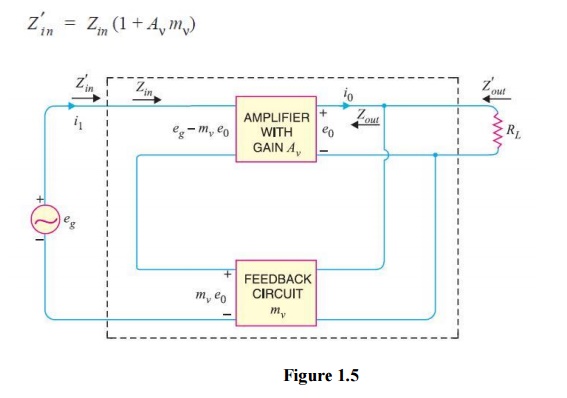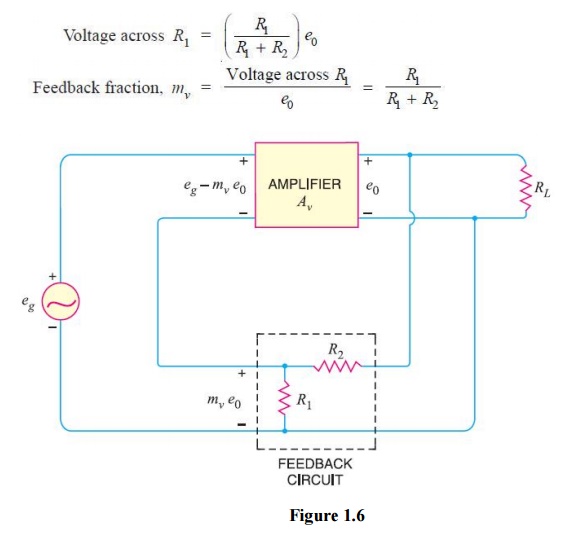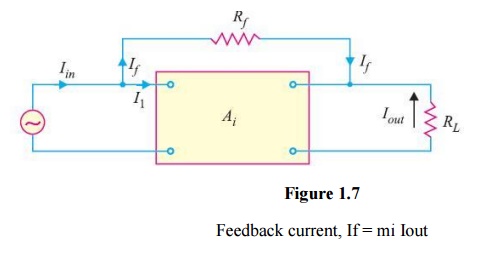(i) Gain stability. An important advantage of negative voltage feedback is that the resultant gain of the amplifier can be made independent of transistor parameters or the supply voltage variations.

For negative voltage feedback in an amplifier to be effective, the designer deliberately makes the product Av mv much greater than unity. Therefore, in the above relation, 1 can be neglected as compared to Av mv and the expression becomes :

It may be seen that the gain now depends only upon feedback fraction mv i.e., on the characteristics of feedback circuit. As feedback circuit is usually a voltage divider (a resistive network), therefore, it is unaffected by changes in temperature, variations in transistor parameters and frequency. Hence, the gain of the amplifier is extremely stable.
(ii) Reduces non-linear distortion. A large signal stage has non-linear distortion because its voltage gain changes at various points in the cycle. The negative voltage feedback reduces the nonlinear distortion in large signal amplifiers. It can be proved mathematically that :

It is clear that by applying negative voltage feedback to an amplifier, distortion is reduced by a factor 1 + Av mv.
(iii) Improves frequency response. As feedback is usually obtained through a resistive network, therefore, voltage gain of the amplifier is *independent of signal frequency. The result is that voltage gain of the amplifier will be substantially constant over a wide range of signal frequency. The negative voltage feedback, therefore, improves the frequency response of the amplifier.
(iv) Increases circuit stability. The output of an ordinary amplifier is easily changed due to variations in ambient temperature, frequency and signal amplitude. This changes the gain of the amplifier, resulting in distortion. However, by applying negative voltage feedback, voltage gain of the amplifier is stabilised or accurately fixed in value.
This can be easily explained. Suppose the output of a negative voltage feedback amplifier has increased because of temperature change or due to some other reason. This means more negative feedback since feedback is being given from the output. This tends to oppose the increase in amplification and maintains it stable. The same is true should the output voltage decrease. Consequently, the circuit stability is considerably increased.
(v) Increases input impedance and decreases output impedance. The negative voltage feedback increases the input impedance and decreases the output impedance of amplifier. Such a change is profitable in practice as the amplifier can then serve the purpose of impedance matching.
(a) Input impedance. The increase in input impedance with negative voltage feedback can be explained by referring to Fig. 13.5. Suppose the input impedance of the amplifier is Zin without feedback and Z ′in with negative feedback. Let us further assume that input current is i1. Referring to Fig. 13.5, we have,

But eg/i1 = Z ′i n , the input impedance of the amplifier with negative voltage feedback.

It is clear that by applying negative voltage feedback, the input impedance of the amplifier is increased by a factor 1 + Aν mv. As Aν mv is much greater than unity, therefore, input impedance is increased considerably. This is an advantage, since the amplifier will now present less of a load to its source circuit.
(b) Output impedance. Following similar line, we can show that output impedance with negative voltage feedback is given by :

It is clear that by applying negative feedback, the output impedance of the amplifier is decreased by a factor 1 + Aν mν. This is an added benefit of using negative voltage feedback. With lower value of output impedance, the amplifier is much better suited to drive low impedance loads.
Feedback Circuit
The function of the feedback circuit is to return a fraction of the output voltage to the input of the amplifier. Fig. 13.6 shows the feedback circuit of negative voltage feedback amplifier. It is essentially a potential divider consisting of resistances R1 and R2. The output voltage of the amplifier is fed to this potential divider which gives the feedback voltage to the input. Referring to Fig. 13.6, it is clear that :

Principles of Negative Current Feedback
In this method, a fraction of output current is fedback to the input of the amplifier. In other words, the feedback current (If) is proportional to the output current (Iout) of the amplifier. Fig. 1.7 shows the principles of negative current feedback. This circuit is called current-shunt feedback circuit. A feedback resistor Rf is connected between input and output of the amplifier. This amplifier has a current gain of Ai without feedback. It means that a current I1 at the input terminals of the amplifier will appear as Ai I1 in the output circuit i.e., Iout = Ai I1.
Now a fraction mi of this output current is fedback to the input through Rf.
The fact that arrowhead shows the feed current being fed forward is because it is negative feedback.

Note that negative current feedback reduces the input current to the amplifier and hence its current gain.
Current Gain with Negative Current Feedback
Referring to Fig. 13.6, we have, Iin = I1 + If = I1 + mi Iout
But Iout = Ai I1, where Ai is the current gain of the amplifier without feedback.
Iin = I1+ mi Ai I1 (ä Iout = Ai I1)
Current gain with negative current feedback is

This equation looks very much like that for the voltage gain of negative voltage feedback amplifier. The only difference is that we are dealing with current gain rather than the voltage gain.
The following points may be noted carefully :
(i) The current gain of the amplifier without feedback is Ai. However, when negative current feedback is applied, the current gain is reduced by a factor (1 + mi Ai).
(ii) The feedback fraction (or current attenuation) mi has a value between 0 and 1.
(iii) The negative current feedback does not affect the voltage gain of the amplifier.

